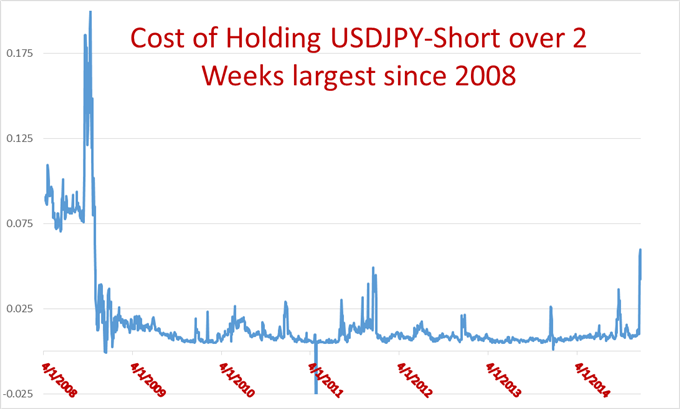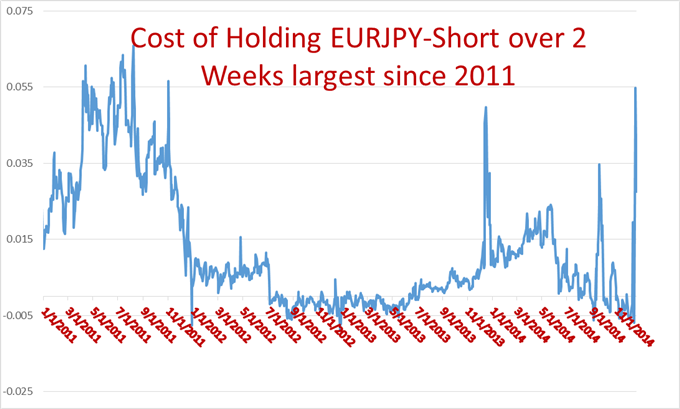- The year-end threatens a liquidity crunch in US Dollar lending markets
- Past quarter-ends have provided similar crunches, produced elevated borrowing costs
- Traders should be wary of holding outsized positions into the year-end
The end of the calendar year threatens to force a liquidity crunch in US Dollar markets, and traders should note risks of elevated financing costs in major FX pairs.
Why Might Rollover Rates Rise Sharply in the Coming Weeks?
A look at interbank forward markets shows that holding Euro and US Dollar-short positions short positions versus the Japanese Yen is near its most expensive since the heights of the global financial crisis in 2008.
If a trader is long the USDJPY they could theoretically collect this difference, but in practice these relative rates are guided by supply and demand and past experience has shown otherwise.,
Cost of Holding USDJPY-Short Position Surges into Year-End
Indeed we saw similarly pronounced surges into the end of the second quarter in Euro pairs; at the time we noted that a single day’s EURUSD financing charge was the rough equivalent of the combined 25 days prior. It seems as though traders may continue to expect similar spikes at month and quarter end. The effect is likewise pronounced in Yen pairs, and in addition to the USDJPY the EURJPY looks especially stretched.
Interbank forwards pricing show that holding a EURJPY-short position for two weeks would cost the most in financing charges since episodes of Euro funding troubles in 2011.
As with the USDJPY, a trader should theoretically be able to collect this difference, but experience over similar episodes showed otherwise.
Given that FX market volatility typically drops significantly in the final weeks of the calendar year, these charges represent an especially large cost to a trader looking to capture smaller currency moves. Indeed, the sharp changes in interbank lending markets could in some cases make the difference between a winning and losing trade.
Understanding Forex Rollover
Trading forex on leverage involves borrowing one currency in order to purchase another. In effect this means traders will pay interest rates for the currency which they sell, while they receive interest rate payments for the currency which they buy. In FX terminology this is most often called “Rollover” or “Swaps”.
Overnight interest rates will guide whether the trader will ultimately pay to hold a position or earn interest on the trade, and typically these interbank rates will track a central bank’s target quite closely. Yet sharp changes in the supply or demand for a specific currency can shift interbank borrowing rates in a hurry.
Traders should be wary of these elevated costs headed into the final weeks of the trading year.
FXCM, L.L.C.® assumes no responsibility for errors, inaccuracies or omissions in these materials. FXCM, L.L.C.® does not warrant the accuracy or completeness of the information, text, graphics, links or other items contained within these materials. FXCM, L.L.C.® shall not be liable for any special, indirect, incidental, or consequential damages, including without limitation losses, lost revenues, or lost profits that may result from these materials. Opinions and estimates constitute our judgment and are subject to change without notice. Past performance is not indicative of future results.
Recommended Content
Editors’ Picks
USD/JPY holds above 155.50 ahead of BoJ policy announcement

USD/JPY is trading tightly above 155.50, off multi-year highs ahead of the BoJ policy announcement. The Yen draws support from higher Japanese bond yields even as the Tokyo CPI inflation cooled more than expected.
AUD/USD extends gains toward 0.6550 after Australian PPI data

AUD/USD is extending gains toward 0.6550 in Asian trading on Friday. The pair capitalizes on an annual increase in Australian PPI data. Meanwhile, a softer US Dollar and improving market mood also underpin the Aussie ahead of the US PCE inflation data.
Gold price keeps its range around $2,330, awaits US PCE data

Gold price is consolidating Thursday's rebound early Friday. Gold price jumped after US GDP figures for the first quarter of 2024 missed estimates, increasing speculation that the Fed could lower borrowing costs. Focus shifts to US PCE inflation on Friday.
Stripe looks to bring back crypto payments as stablecoin market cap hits all-time high

Stripe announced on Thursday that it would add support for USDC stablecoin, as the stablecoin market exploded in March, according to reports by Cryptocompare.
Bank of Japan expected to keep interest rates on hold after landmark hike

The Bank of Japan is set to leave its short-term rate target unchanged in the range between 0% and 0.1% on Friday, following the conclusion of its two-day monetary policy review meeting for April. The BoJ will announce its decision on Friday at around 3:00 GMT.

